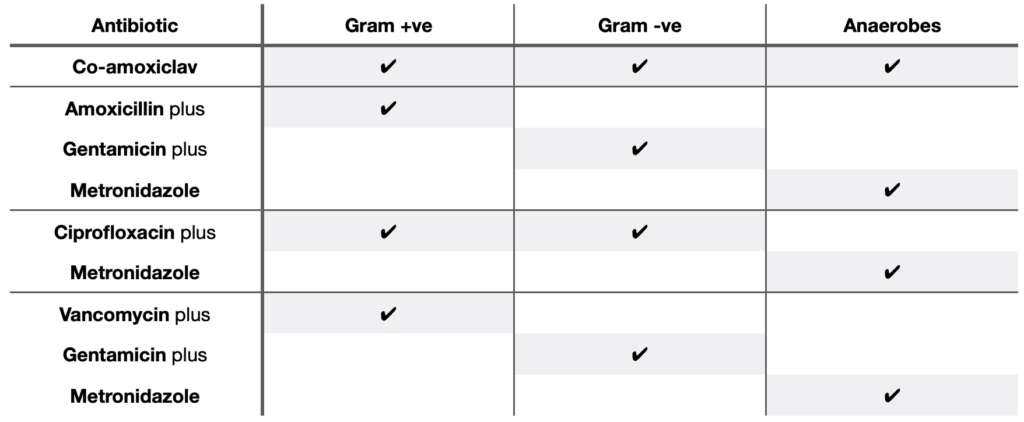There is a long list of possible intra-abdominal infections:
- Acute diverticulitis (infection in intestinal diverticula)
- Acute cholecystitis (with secondary infection in the gallbladder)
- Ascending cholangitis (infection in the bile ducts)
- Appendicitis (infection in the appendix)
- Spontaneous bacterial peritonitis (infection in the fluid in the peritoneal cavity)
- Intra-abdominal abscess
Bacteria
Common bacterial causes of intra-abdominal infections include:
- Anaerobes (e.g., Bacteroides and Clostridium)
- E. coli (gram-negative)
- Klebsiella (gram-negative)
- Enterococcus (gram-positive)
- Streptococcus (gram-positive)
Antibiotics
Intra-abdominal infections require broad-spectrum antibiotics until culture results are available. Antibiotics need to cover gram-positive, gram-negative and anaerobic bacteria.
Co-amoxiclav provides good gram-positive, gram-negative and anaerobe cover. It does not cover pseudomonas or atypical bacteria.
Quinolones (e.g., ciprofloxacin and levofloxacin) provide gram-positive, gram-negative and atypical cover. However, they do not cover anaerobes, so they are usually paired with metronidazole for intra-abdominal infections.
Metronidazole provides excellent anaerobe cover but does not provide any cover against aerobic bacteria.
Gentamicin provides excellent gram-negative cover and some gram-positive cover (particularly against staph). It is bactericidal, killing bacteria rather than just slowing them down.
Vancomycin provides excellent gram-positive cover, including MRSA. It is often combined with gentamicin (for gram-negative cover) and metronidazole (for anaerobe cover) in patients with penicillin allergy.
Cephalosporins provide good broad-spectrum cover against gram-positive and gram-negative bacteria but are not very effective against anaerobes. They are often avoided due to the risk of Clostridium difficile (C. diff) infection.
Piperacillin with tazobactam (tazocin) and meropenem are powerful antibiotics that cover gram-positive, gram-negative and anaerobic bacteria. They do not cover atypical bacteria or MRSA. Tazocin does not cover ESBLs. They are usually reserved for very unwell patients and those not responding to other antibiotics.
Local antibiotic policies will determine the choice based on local resistance and infection control issues. Typical regimes for treating intra-abdominal infection are:

Last updated July 2023
